How to conduct a risk assessment for a sub-contractor
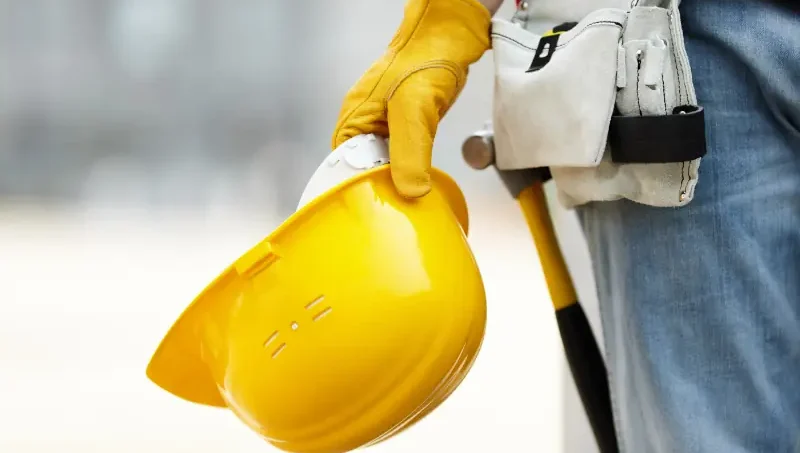
1. Introduction to the workplace
Knowing how to conduct a risk assessment for a sub-contractor is vital in order to identify the hazards they face and then control the risks from those hazards. In order to do that the process must be methodical, beginning with the location of the workplace.
The building is a private owner occupied residence which is undergoing refurbishment to convert it from an old style acre cottage in County Kildare to a modern style open plan residence which is energy efficient and suitable for raising a young family in.
The refurbishment consisted of removing some internal walls and floor coverings, the remodelling of the kitchen and bathroom and complete redecoration of the home. The family moved out for the refurbishment which lasted approximately 21 days. In this time there were several trades on site including the main contractor, a plasterer, two painter and decorators, an electrical contractor and a tiling contractor.
This risk assessment will focus on the tiling contractor and the hazards and the risks from those hazards presented during the course of the work and the control measures put in place to reduce the risks. The tiling contractor is a self-employed sole trader who is 54 and has 20 years’ experience in construction and tiling. He holds a safe pass card and manual handling and abrasive wheels certificates. The work to be completed for the contract is the fitting of the bath, the tiling of the bathroom wall and the kitchen and bathroom floor.
The work for the tiler is divided into two distinct physical areas. The first is where the mixing of the adhesives and grouts takes place along with the cutting of the tiles with the angle grinder as can be seen in figure 1. This area is in an outbuilding next to the house and an area that only the tiler uses. This is an engineering solution to keep the noise, dust and electrical hazards away from other workers and so protecting them from the hazards from that part of the work of the tiler.
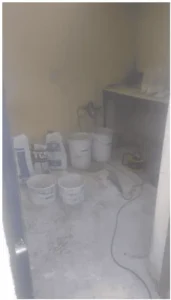
The Mixing & Cutting area
The second work area is the main part of the house. This is where the tiling and works associated with tiling takes place as seen in figure 2. In this area the other trades will be working at the same time but not necessarily in the same room. Noise and dust will be made by all trades so FFP2 dust masks and ear defenders are close at hand. Trailing live cables are always an issue on sites but as the tilers tools are in a remote building on this contract it is not an issue. However the other trades cables are along with the tools they are connected to, so care should be taken in moving around the site as well as housekeeping by the other trades in order to remove the hazards. A ‘toolbox talk’ or ‘site meeting’ with the other trades often solves these issues before they arise in order to keep the site safe for all.
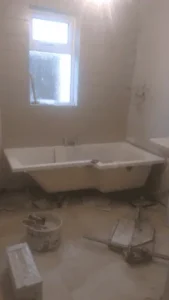
The Tiling area
2. Legislation for Risk Assessment
The construction sector is regulated with a series of Acts, Regulations and Codes of Practices which governs the way the sector operates. Many of these affect tiling contractors and the way that they perform their duties and are set out below.
2.1 Safety, Health and Welfare at Work Act 2005
Section 19: This states that a hazard identification of the workplace should take place and from that a risk assessment should be performed. This should look at all hazards to workers from entry to site to exit on completion of work and is done by walking through the site and identifying all hazards. Identified hazards should be recorded and a risk assessment should be performed on each hazard. This has been done and the results have been set out in the next chapter.
2.2 Safety, Health and Welfare at Work (General Application) Regulations 2007
- Chapter 5 Part 1 Noise: Noise is measured in dB and the regulations state lower exposure action values of 80dB and peak of 135dB, upper exposure action values of 85dB and peak of 137dB and limit value of 87db and peak of 140dB. This is the time weighted average over the course of an 8-hour day and the peak noise levels that can be made before action has to be taken. This is written as LEX,8h = 87 dB(A) and ppeak = 140dB(C). Every piece of equipment that makes noise has dB ratings on a label. So the angle grinder, the electric hammer and the drill mixer used by the tiler have dB ratings on them.
- Chapter 5 Part 2 Vibration: Vibration is measured in m/s2 and is defined as rapid movement to and fro or oscillating movement (HSA, 2007). It can affect the body in 2 areas Hand Arm Vibration (HAV) and Whole Body Vibration (WBV). Tilers are only affected by HAV and the daily exposure action value is 2.5 m/s2 and the exposure limit value is 5 m/s2 for HAV. As is usual in noise and vibration on construction sites the same tools are responsible for noise and vibration. So the angle grinder, the electric hammer and the drill mixer all create vibration and each machine has a plate denoting the vibration generated.
- Chapter 5 Part 3 Electricity: The normal voltage that construction sites work at is 110v but there has been a move toward battery powered tools in recent years which makes the workplace far safer. Part 3 of the regulations in regard to tiles then refers to the use of RCD’s that protect any tool that are plugged into a 220v supply for battery charging or the use of a transformer.
- Chapter 3 Part 2 Personal protective equipment: After an assessment has been made which shows that the risks cannot be avoided then PPE should be worn. In the case of a tiler this would be a dust mask, gloves and suitable eye protection. Even though the tier is self-employed the PPE has to be stored and maintained correctly.
- Chapter 4 Part 2 Manual handling: The Act says that where possible the avoidance of risk should be used. But tiles have to be carried and the weight of the tiles has also to be indicated on the box. So if the box of tiles is over 20kg then the best option is to open the box and carry part the tiles in smaller amounts. This reduces the risk as indicated in S.69 of the Act.
2.3 Safety, Health and Welfare at Work (Construction) Regulations 2013.
- The main dangers on a construction site have passed by the time a tiler arrives as the building is normally finished but certain parts apply.
- Part 4 General safety provisions: Access and egress and emergency exits affect all workers including tilers.
- Schedule 4 Safety Awareness scheme: This states that to be on a construction site a Safe Pass registration is required.
2.4 Safety, Health and Welfare at Work (Chemical Agents) Regulations, 2001
Schedule 1: Lists the chemical agents and the Occupational Exposure Limit Values (OELV). There are 2 that effect tilers, Portland cement which what tile adhesive is made from and silica dust from removing old tiles from concrete floors, both are listed and have an OELV. Portland cement is OELV 8hr 10 mg/m3 for inhalable dust and 4 mg/m3 for respirable dust. It is much less for inhalable dust because that can get into the alveoli in the base of the lungs. Once it is there it cannot be removed and can over time get clogged. Silica crystalline, respirable dust has an OELV of 8hr 0.1 mg/m3 as this can be so damaging to airways and alveoli. These figures indicate that there is danger from both chemicals and care should be taken when working with both of these items.
3. Hazard Identification
A hazard as defined by the Health & Safety Authority (HSA) as ‘A Hazard is a potential source of harm or adverse health effect on a person or persons’ . Hazards can be grouped into the 5 main hazard areas such as physical or health etc. or by the individual hazard such as an angle grinder and the hazard areas applied to each hazard. For the purposes of this report the 5 hazard areas have been used. In order to identify the hazards an inspection of the tilers work areas has to take place. The identified hazards have been put in the hazard group according to their type.
3.1 Physical hazards
- Slips trips & falls: acute, trailing leads, discarded tiles
- Manual handling: acute/chronic, lifting & carrying of tiles & adhesives
- Working at height: acute, the use of a step ladder to fit tiles close to ceiling
- Electrical tools: acute, being cut by rotating disc of angle grinder, sparks from cutting tiles
- Hand tools: acute, being cut or injured by incorrect use of knives hammers or chisels
- Electricity: acute, trailing cables in water, no rcd used with 220v tools,
- Other workers: acute, injuries from their tools, systems of work or poor housekeeping
3.2 Health hazards
- Vibration: chronic, from use of angle grinder and mechanical hammer
- Noise: chronic, from the use of power tools
- Silica dust: chronic, from the mechanical mixing of adhesive and the removal of old tiling from concrete floors
- Temperature: acute/chronic, working inside with no heating and outside at low temperatures
- Repetitive strain injury: chronic, from constant use of manual tile cutting machine
- Lone working: acute, from doing the job of 2 to get the job done resulting in accident
3.3 Chemical hazards
- Dust: chronic, from the mechanical mixing of adhesive and the removal of old tiling from concrete floors
- Fumes: chronic/acute, from resins and sealers
- Wet cements: acute/chronic causing chemical burns and dermatitis
3.4 Biological hazards
- Weils disease: acute, from cutting tiles and mixing adhesives in an area where vermin are known to have been
3.5 Human factor hazards
- Long hours and/or late working: chronic, from tiredness and psychosocial stress
- Lone working: chronic, from isolation causing psychosocial stress
4. Risk Assessment
A risk as defined by the HSA is ‘risk is the likelihood that a person may be harmed or suffers adverse health effects if exposed to a hazard.The 6 most serious hazards have been identified and a detailed Risk Assessment has been completed on each. The Risk Assessment matrix used has been described and shown in Fig 1 below.
It works by multiplying the likelihood of the accident happening by the severity of the resulting accident. So for example the likelihood of a tiler breathing in adhesive dust is low but not negligible so 2 but the severity of the resulting injury is quite high so 4, so 2 multiplied by 4 is 8 which is the red zone. At this point the work should cease and control measures should be put in place. In this case it would be an FFP2 face mask and do the mixing outside or in a well ventilated area.. So to risk assess again the likelihood of breathing in adhesive dust is now 1, multiply that by the severity which would still be 4 results in 4. This is in the amber zone, there is still a risk but the mask maintains an awareness of that risk and judgement should be applied as to where the work should be performed. The most serious hazard is the first listed and the results have been set out after the matrix.
4.1 The 5×5 Risk Assessment Matrix
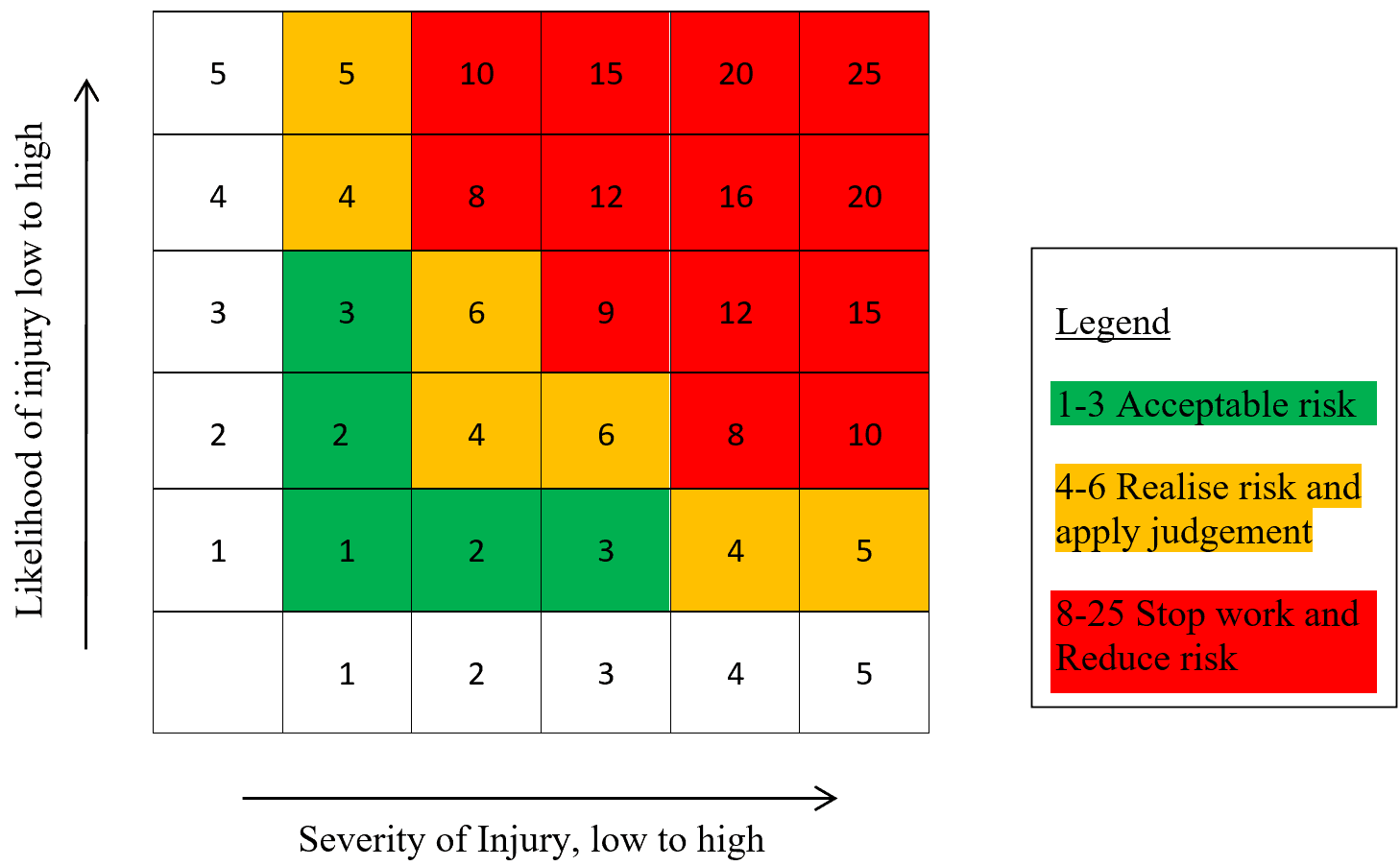
This type of risk assessment matrix has been used because of its simplicity and its traffic light colour to indicator the levels of risk.
- The green areas indicate low levels of risk; both the likelihood and the possibility of severe injury are low so the risks are acceptable.
- The amber areas indicate a level of risk where consideration has to be given to the task before the task is attempted; control measures should be put in place to reduce these risks.
- The red areas indicate areas of high levels of risk, where the likelihood or severity (or both) of injury are high. Measures should be put in place to reduce that risk. The chosen control measures should be put in place before the task is attempted.
4.2 Risk assessments listed by hazard
Chemicals risk assessment
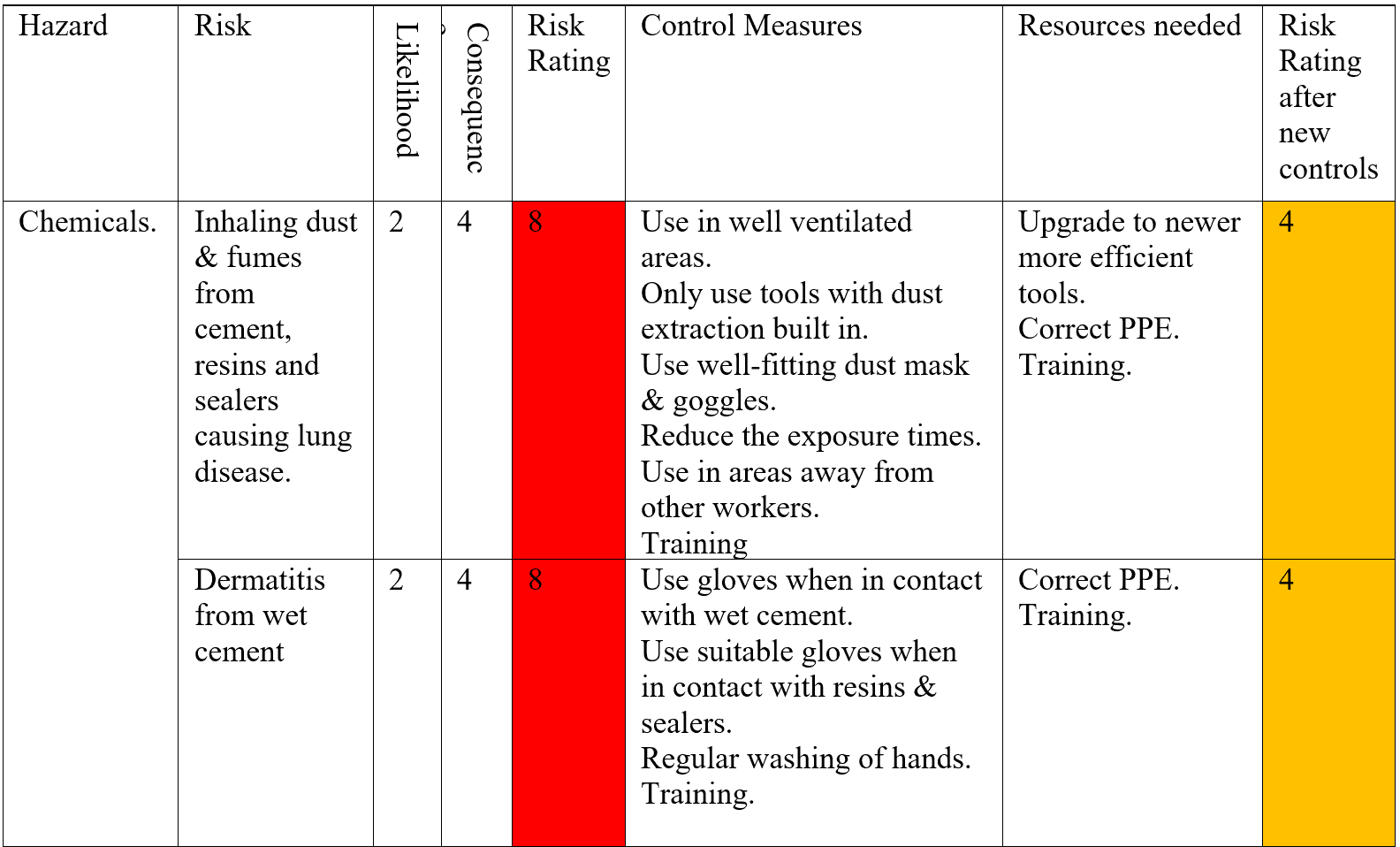
Electricity risk assessment
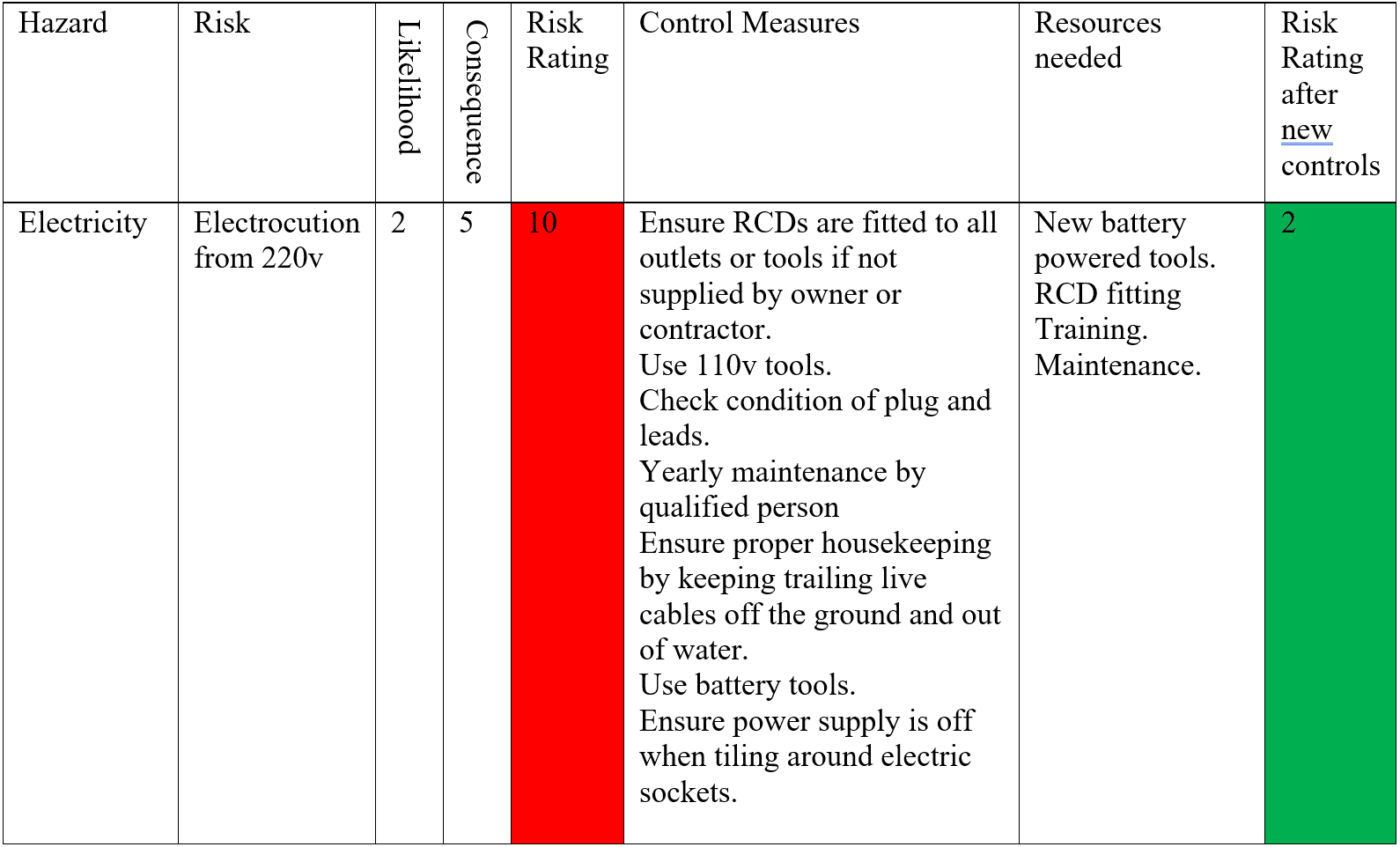
Noise risk assessment
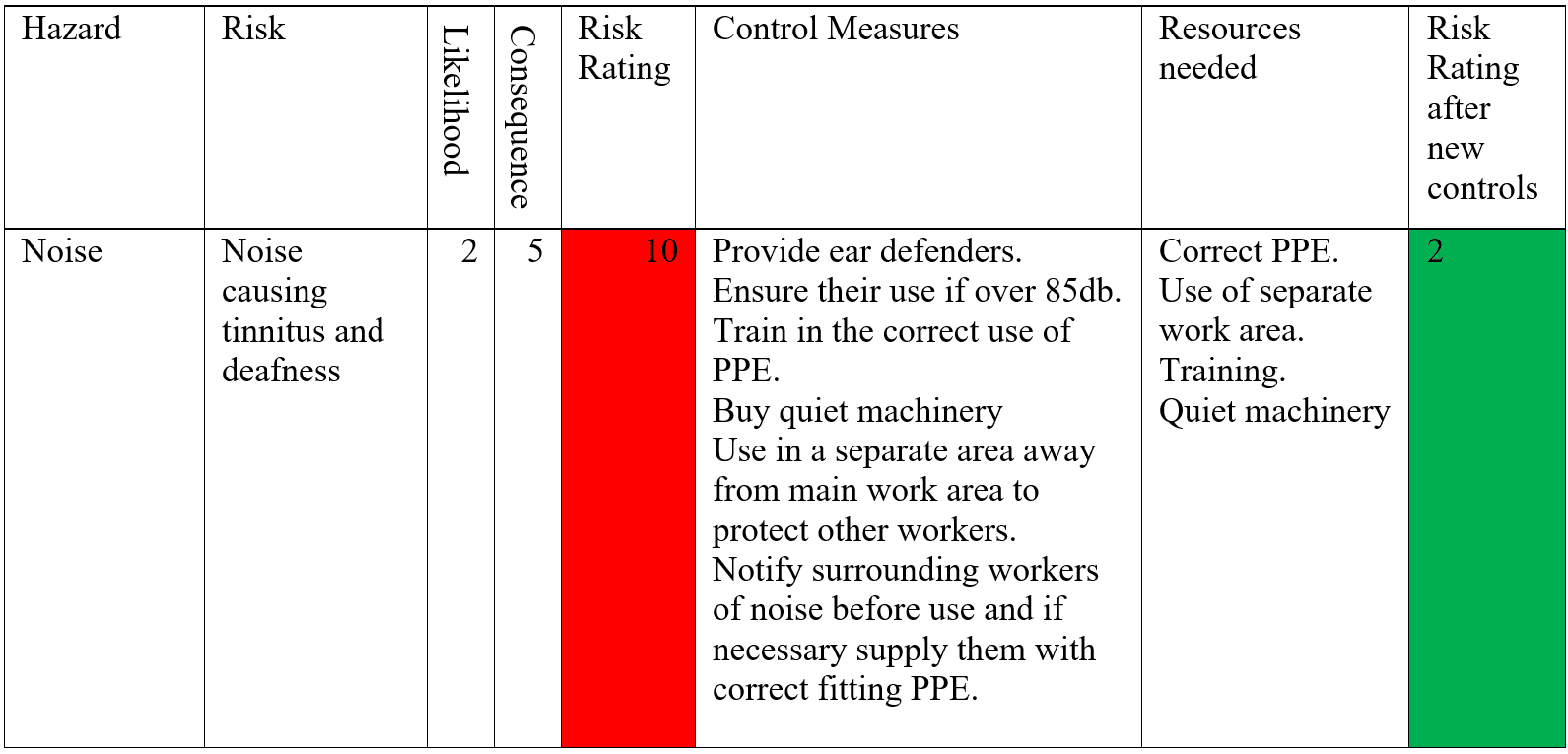
Manual handling risk assessment
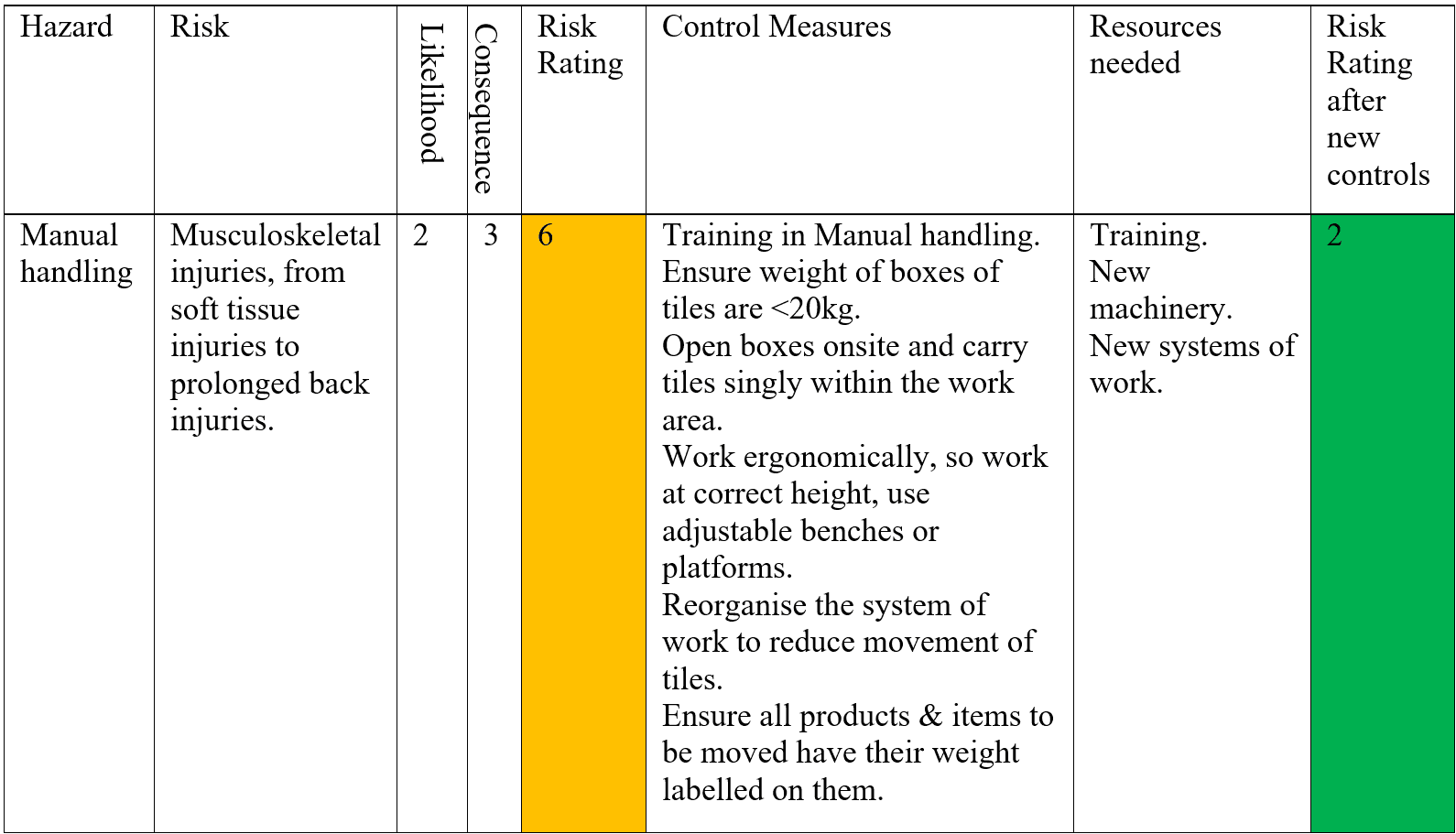
Vibration risk assessment
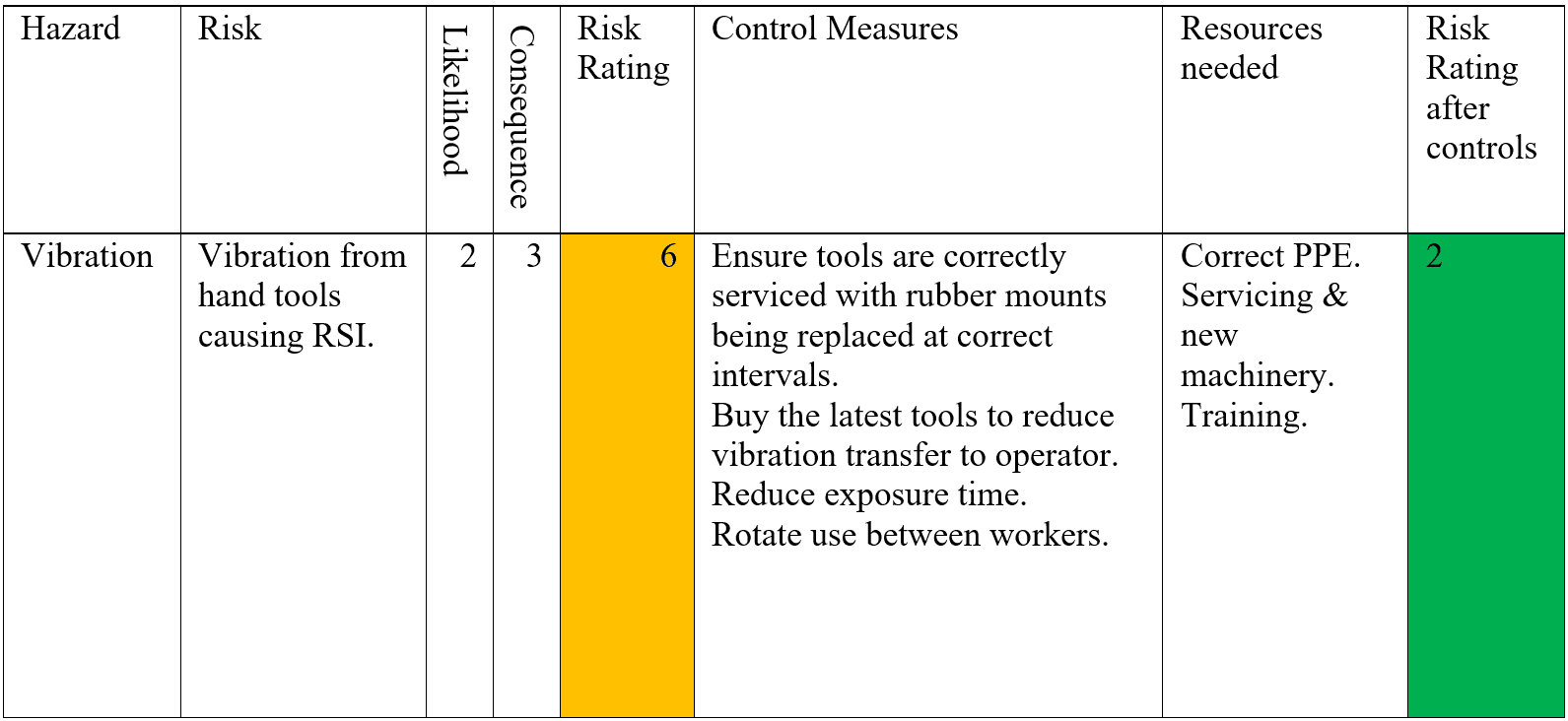
Biological risk assessment
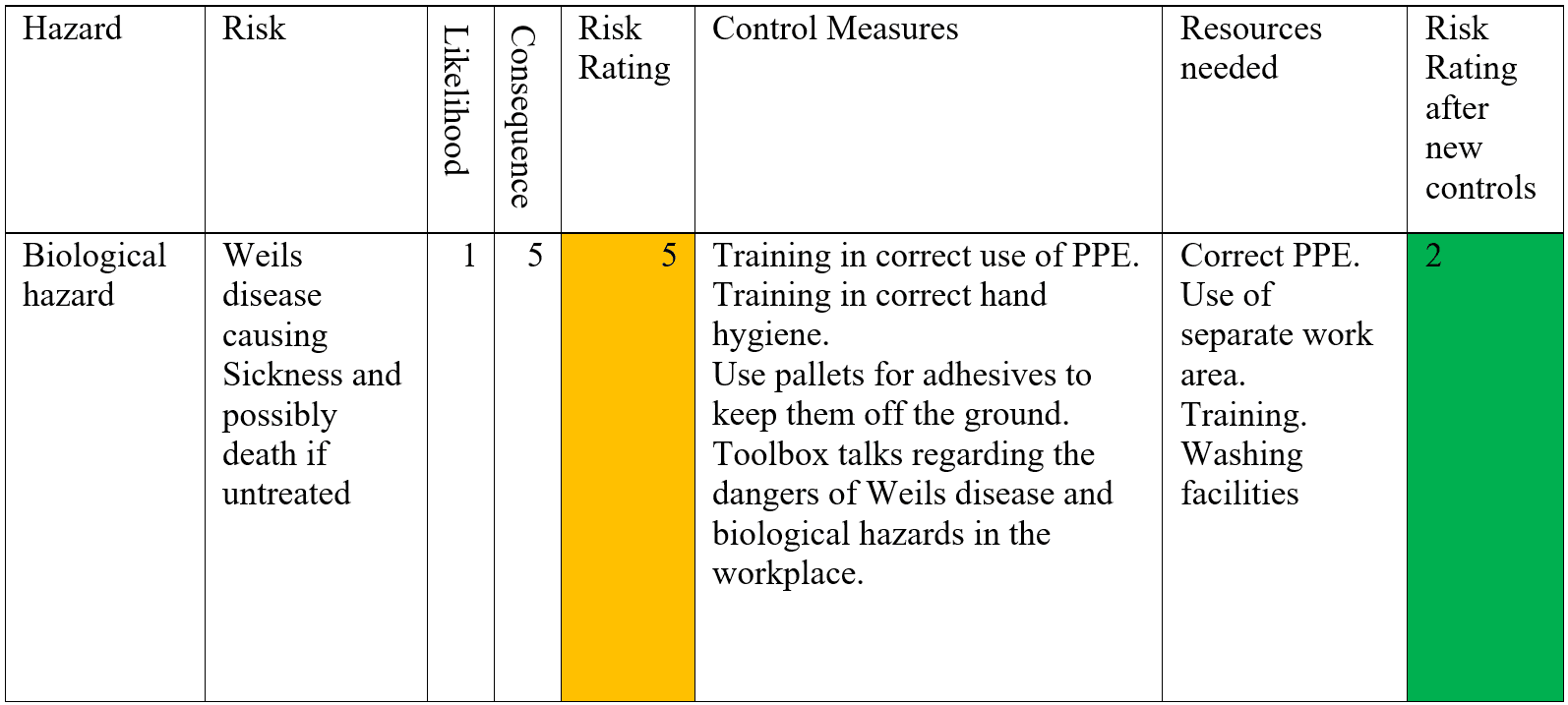
5. Conclusion
Hazards are present in all workplaces and can come in many guises. Some are easy to see such as a trailing cable on the floor and some are hidden such as Weil’s disease, which may not be noticed possibly until it’s too late. Awareness of hazards reflects an awareness of the workplace and its surroundings, both of which are vital in performing hazard identification and then a risk assessment. This is why the person who should do this must be familiar with the workplace and its surroundings or if not then that person must be qualified and competent to do because if they’re not the hidden hazards could be missed, possibly at a great cost.
© SafetyTraining.ie 2024